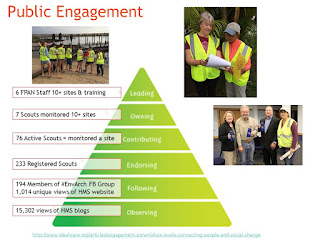Conversations about Conferences: Tidally United 2017
 |
| Click here to view Tidally United 2017 program. (Photo: FPAN SW) |
No one was home earlier this month as we traveled to Hollywood, Florida to attend the 2nd annual Tidally United Summit. Reporting to you with another installment of Conversations about Conferences to fill you in on where we are when we're not in the office!
Tom Dawson and Joanna Hambly of SCAPE at St. Andrews before their SCHARP conference last year and here in Florida in the Everglades.

EmJ: What did you hope to
get out of it?
Sarah: I definitely hoped to learn more about Seminole and Miccosukee people, I knew that would be a big takeaway. I also hoped to share the amazing work of the Heritage Monitoring Scouts over the past year and and share the credit for what so many people are doing around the state. My paper was first up in the Bird Clan room after the welcome from FPAN Director Sara Ayers-Rigsby, Samuel Tommie of the Seminole Tribe, and Jr. Miss Seminole Princess herself Kailani Osceola. Look for the first year annual report of HMS Florida to be posted to the blog next month.
 |
| My hero: Betty Osceola, member of the Miccosukee tribe and Panther clan. |
 |
| Kailani Osceola, Jr. Miss Florida Seminole Princess |
 |
| Samuel Tommie, member of Seminole tribe Bird Clan |
 |
| Joe Frank, Big Cypress Representative, Seminole Tribe Board of Directors |
It was also interesting too to see the diversity of ways climate change impacts are happening around Florida. Paulette McFadden who presented a poster on the Garden Patch site (read Rachael Kangas' blog post on this site!) on the Gulf side has a completely different scenario than Margo Schwadron who reported on shell islands on the south west coast. Case studies from around the state by FPAN staff highlighting HMS Florida training and monitoring opportunities also demonstrated the wide variety of sites impacted, and variety of impacts.
Paulette McFadden from Florida's Bureau of Archaeological Research presents her poster on the Garden Patch site, Margo Schwadron from the Southeastern Archaeological Center (NPS) sharing a moment with Betty Osceola on the afternoon panel, ladies of FPAN (Emily Jane Murray, Kassie Kemp, and Rebecca O'Sullivan) share HMS Florida case studies from around the state.
Paulette McFadden from Florida's Bureau of Archaeological Research presents her poster on the Garden Patch site, Margo Schwadron from the Southeastern Archaeological Center (NPS) sharing a moment with Betty Osceola on the afternoon panel, ladies of FPAN (Emily Jane Murray, Kassie Kemp, and Rebecca O'Sullivan) share HMS Florida case studies from around the state.
Sarah: This year the presentations were split into two rooms, so being in two places at the same time was impossible. Luckily the presentations were recorded and streamed live on Miccosukee TV! I really wanted to hear many of the papers in the other room, especially on Egmont Key and Austin Burkhardt's QR tagging project, but stayed put in the Bird Clan room all day. You can view the livestream provided by Seminole Media Productions and watch the 11 segments again and again from the website.
 |
| Livestream provided by Seminole Media Productions, click to view all segments. |
 EmJ: So we attend a lot of
conferences in a year - what from this Tidally United will you bring back to
the public for their benefit?
EmJ: So we attend a lot of
conferences in a year - what from this Tidally United will you bring back to
the public for their benefit?
Sarah: Some of the papers in the afternoon were on image and media surrounding climate change and heritage issues. I think it is important to continue to challenge ourselves to make the invisible visible. It's always been the challenge of archaeology, how to make subsurface features come to life above ground. And now adding water all around it...there needs to be ways to bring the public into the conversation without scaring people about doomsday scenarios. I think that's what I found most comforting from the Miccosukee and Seminole point of view, they are not leaving. There is no tipping point for which a site is abandoned. The land will change and meeting basic needs will become more challenging, but abandonment in place is not an option for them.
Sarah: So far I know when, where and who. The Summit will be spearheaded by FPAN West Central in Tampa in partnership with the Weedon Island Preserve, August 2018. Safe to say Tampa is not prepared to face the changes brought about by climate over the next 50-100 years. The Gulf side of Florida is completely different than our northeastern shores and the Everglades. Will be a good year to hear from new partners and new approaches by USF faculty and students.
We hope to see many of you there!
Text and images: Sarah Miller, FPAN staff except top image by FPAN SW
For more information check out official website for current year of Tidally United and archive of past Tidally United (2016).
Special thanks to the event committee: Sara Ayers-Rigsby, Paul Backhouse (Seminole THPO), Paulette McFadden, Jeff Moates, Margo Schwadron, Misty Snyder, and Dennis Wiedman.
Extra special thanks to the Ah-Tah-Thi-Ki Museum, Tribal Historic Preservation Office, Mallory Fenn, Rachael Kangas, Everglades National Park, and the Chairman, Council, and communities of the Seminole Tribe of Florida.
















